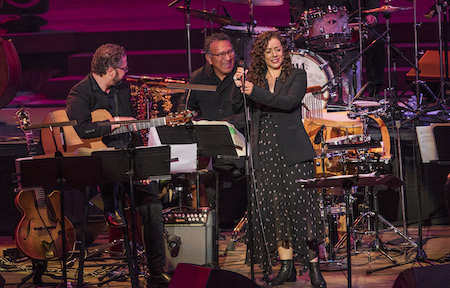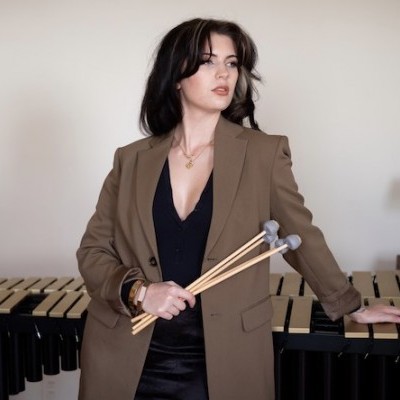Jun 3, 2025 11:25 AM
In Memoriam: Al Foster, 1943–2025
Al Foster, a drummer regarded for his fluency across the bebop, post-bop and funk/fusion lineages of jazz, died May 28…

Luciana Souza performs with Vince Mendoza’s Storytellers Big Band at the Angel City Jazz Festival on Oct. 21.
(Photo: Courtesy Angel City Jazz Festival)Luciana Souza gazed out at the large crowd that filled the amphitheater, gestured at the big band behind her and proclaimed, “You will never see this band again on the same stage.”
She might be correct in that, but no one had ever seen this band before that night either, making this a singularly historic event for those gathered at the Ford, a 1,200-seat outdoor venue built on the same hill as its bigger, more famous brother, the Hollywood Bowl.
Souza, one of the most celebrated Brazilian singers in recent memory, was backed by a jazz ensemble led by composer-arranger (and five-time Grammy winner) Vince Mendoza, stocked with a who’s who of local jazz luminaries: trumpeter Wayne Bergeron, saxophonist Bob Sheppard, guitarist Larry Koonse, bassist Darek Oles, percussionist Alex Acuna and drummer Peter Erskine, to name just a few. Perhaps not all the aforementioned are as well-known to the rest of the country and world, but they are rightfully revered by colleagues, students and fans alike in the City of Angels, where almost the entire band calls home, including Souza and Mendoza. For all the grandeur and pomp of the gala concert, it still felt like a family affair, a reunion of sorts. An opportunity for everyone to recognize their home team is also an all-star team.
This was the opening night of the Angel City Jazz Festival (Oct. 21–Nov. 5), the annual autumn three-week saturation of innovative jazz music throughout Los Angeles. And the particulars of the evening revealed an important shift in how the festival has modified its vision over the 12 years since its inaugural season in 2010. “When we first started,” said Rocco Somazzi, the founder and producer of the ACJF, “we wanted to do all out-of-town artists, because we felt the city needed more exposure to that kind of music. But gradually we realized there were many great artists who were either already living here or had recently moved here, and now we also want to show people the very best that L.A. has to offer.”
Much of the music that night came from Souza’s 2020 collaboration with Mendoza, Storytellers (Sunnyside), recorded in Germany with the WDR Big Band Cologne. Mendoza was able to complement Souza’s warm and clear voice with equally inviting and compelling arrangements, often incorporating her voice as part of the full ensemble. The encore closer, “Choro #3,” showcased Acuna with a brilliant solo intro on a myriad of percussion instruments, and featured Souza’s patented ability to sing endless winding unison lines with guitar, also doubled by the woodwind section, saving for last the most complex and intricate piece of the evening.
And that was just the first of what was to be 13 different shows on eight nights of music over three October and November weekends. This writer made his best effort to see as many of these as possible, ultimately making it to six nights and nine of the 13 sets. What follows is a brief diary of the experience.
The World Stage, the Leimert Park community jazz space founded in 1989 by drummer Billy Higgins, was jammed with people clamoring for a rare chance to see free-jazz icon David Murray. The saxophonist unleashed a relentless cavalcade of sound and joyous fury, punctuated by extended techniques at the extreme upper and lower ranges of the horn. He drifted easily in and out of double time, blurring and obscuring the beat with assistance from bassist Roberto Miranda and drummer Malachi Whitson. The coup de grace was a final cadenza, stunning display of rapid multi-phonics that seemed to make the room vibrate.
The following weekend began early on a Friday evening, where drummer Jonathan Pinson led his outsize group, Boom Clap, at the popular Friday jazz concert series at the Los Angeles County of Modern Art. Pinson is not bashful — rather he is full of bash, as he attacked the drums with a fervor that elicited many cheers from what seemed like more than a thousand people in attendance around the outdoor stage. All of Pinson’s fellow musicians were extremely talented, younger and hipper, and all the songs had a groove, possibly at times venturing into smooth, but like cognac as opposed to cheese. A definite crowd pleaser in any case.
Another full house packed the auditorium in the basement of the Barnsdall Gallery in Hollywood, the site of the very first Angel City Jazz Festival. Tenor saxophonist Daniel Rotem was leading his own band of L.A. jazz veterans: Bassist Darek Oles (also seen at the Ford), drummer Joe La Barbera, and pianist Billy Childs. They played selections from Rotem’s recent album of re-imagined works by John Coltrane. Rotem was able to somehow capture the spirit and intent of the jazz giant, while turning those hallowed compositions into new creations that also reflect Rotem’s own thoughtful and eloquent mind.
Ben Wendel, the second act of the evening, has made quite a name for himself since moving to New York from Los Angeles in 2010, but it had been a while since he last performed in L.A. “It’s kind of nostalgic being back here,” the tenor saxophonist announced from the stage. He and vocalist Michael Mayo (also a former Angeleno) traded improvised phrases for a bit before Wendel launched into his own solo, his gigantic sound generating visceral energy and controlled chaos. Pianist Fabian Almazan contributed a rumbling free piano solo, enhanced by running the sound through effects controlled by his left foot on an expression pedal. Bassist Harish Raghavan and drummer Nate Wood also used to live in Los Angeles, and the latter was featured near the end, using electronic music concepts of layering various patterns in an organized yet dramatic fashion. Before their last tune, Ben thanked Somazzi. “There’s always one person who creates a scene in a city,” he said, “and Rocco is that person.”
The third and final weekend of the festival began in downtown Los Angeles, at the Colburn School’s Thayer Hall. L.A.-based alto saxophonist Nicole McCabe brought her sextet in to perform her series of pieces dedicated to various female mentors that have guided her life and career. Her clever writing for horns alternated between strong unison lines and dense cluster harmonies, the tension in the chords never obscuring the melody or the intent. There was plenty of room for her bandmates to explore individually, but it was the bandleader herself who led the way with two strategically well-timed solos that demonstrated a dizzying array of virtuosity and creativity, finding new things to say on the alto saxophone.
McCabe was followed by pianist Myra Melford, who brought her entire quintet to Los Angeles to play the music of their new album, For The Love Of Fire And Water (Rogue Art). The pianist jumped right in with a careful, rumbling introduction; her precise atonal figurations seemed to dance out of the piano. Cellist Tomeka Reid joined in with a stirring response on bowed cello, followed by sensitive percussive elements by drummer Lesley Mok. Ingrid Laubrock’s tenor saxophone added to the collective intensity, and guitarist Mary Halvorson completed the fifth layer of sound with looping hiccups and a simultaneous wailing with Reid’s cello. And all that was just the introduction to the first piece, but a harbinger of what was to come, the five women working in telepathic unity to swirl their collective ideas around the stage and out into the hall, achieving an upper echelon of free jazz not often attained by most.
The closing night of the festival at the Echo Park club 2220 Arts + Archives paired two more saxophonists, both young and up-and-coming, but apart from that they could not have been more divergent. Devin Daniels led a modern hard-bop quintet representative of the emerging youth movement in Los Angeles jazz. Daniels’ alto tone was big and open with a slight growl, at once inviting and menacing as he sliced rapidly though all the challenging material with razor-sharp precision.
After the intermission, Zoh Amba, 22 years young, walked onto the stage, a gentle and seemingly harmless presence. The surprise came when she put her horn in her mouth. A strident lament emanated from her tenor, as if it was crying out in anguish before the ordeal it was about to endure from Amba’s powerful and vicious sonic attacks, assisted with distorted and disjointed shredding by guitarist Wendy Eisenburg. Bassist Mark Dresser was also a willing accomplice, providing additional terror through his innovative bowing and plucking technique and effects pedals. One could feel the audience breathe a sigh of relief, clapping appreciatively when it was over, undoubtedly glad to still be alive. Ultimately, that is the feel-good moment of any Hollywood horror movie.
There were plenty of other things to feel good about throughout the festival, most of all the opportunity to see and hear the multiple currents of style, region and generation mix and blend together. And with all events at or near capacity, it definitely is a good feeling to know there is an audience in Los Angeles for the diverse kinds of jazz on display, linked by a commitment to artistry and authenticity. DB

Foster was truly a drummer to the stars, including Miles Davis, Sonny Rollins and Joe Henderson.
Jun 3, 2025 11:25 AM
Al Foster, a drummer regarded for his fluency across the bebop, post-bop and funk/fusion lineages of jazz, died May 28…

“Branford’s playing has steadily improved,” says younger brother Wynton Marsalis. “He’s just gotten more and more serious.”
May 20, 2025 11:58 AM
Branford Marsalis was on the road again. Coffee cup in hand, the saxophonist — sporting a gray hoodie and a look of…

“What did I want more of when I was this age?” Sasha Berliner asks when she’s in her teaching mode.
May 13, 2025 12:39 PM
Part of the jazz vibraphone conversation since her late teens, Sasha Berliner has long come across as a fully formed…

Roscoe Mitchell will receive a Lifetime Achievement award at this year’s Vision Festival.
May 27, 2025 6:21 PM
Arts for Art has announced the full lineup for the 2025 Vision Festival, which will run June 2–7 at Roulette…

Benny Benack III and his quartet took the Midwest Jazz Collective’s route for a test run this spring.
Jun 3, 2025 10:31 AM
The time and labor required to tour is, for many musicians, daunting at best and prohibitive at worst. It’s hardly…